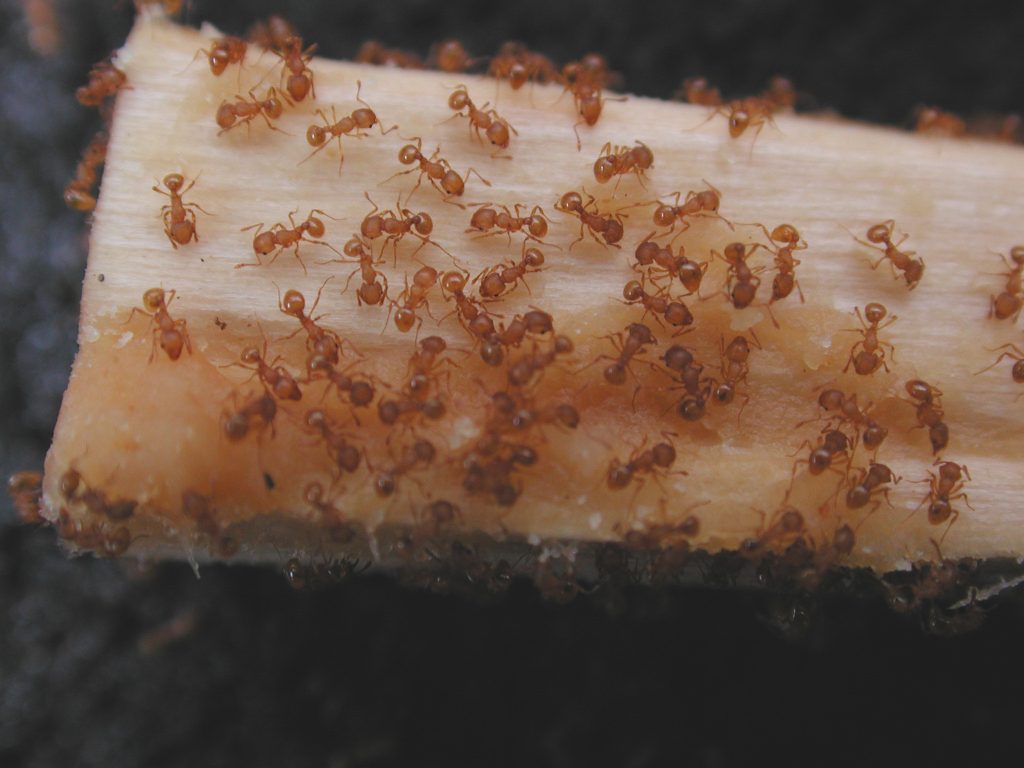October is ‘Stop the Ant Month’ in Hawaiʻi

A multi-agency “Stop the Ant” campaign will be underway in Hawaiʻi in October to increase awareness about the importance of early detection to prevent and control the spread of the invasive little fire ant.
Although the little fire ant (LFA) is tiny, measuring 1/16th of an inch and moves slowly, it is considered among the worldʻs most invasive species. The ants are originally from South America and pale orange.
Little fire ants can produce painful stings and large red welts, and may cause blindness in pets. They can completely overrun a property by building large colonies on the ground, in trees and other vegetation, and inside buildings and homes.
Little fire ants are different than the tropical fire ant, which is established in Hawai`i, can move quickly, and is much larger with a larger head in proportion to its body.
Residents on Maui County, Oʻahu and Kauaʻi are asked to survey their properties for little fire ants by using a little peanut butter on a chopstick and leaving them in several areas for about one hour. Residents may request a free ant-collection kit through the website: http://stoptheant.org/. The website also has maps of areas where little fire ants have been detected in Hawaiʻi.

The Department of Land and Natural Resources has produced a three-minute video, “How to Test for LFA,” which shows the step-by-step procedure for testing for little fire ants. The video is available on the Stop the Ant website and at: https://vimeo.com/97558997.
Any ants collected should be put in a sealable plastic bag, placed in the freezer for at least 24 hours and dropped off or mailed to the Invasive Species Committee office on your island.
- Maui/Lānaʻi Invasive Species Committee, 808-573-6472, PO Box 983, Makawao, HI 96768
- Oʻahu Invasive Species Committee 808-266-7994, 743 Ulukahiki Street, Kailua, HI 96734
- Molokaʻi/Maui Invasive Species Committee, 808-553-4236, PO Box 220, Kualapuu, HI 96757
- Kauaʻi Invasive Species Committee, 808-821-1490, 7370K Kuamoo Road, Kapaa, HI 96746
“The treatment plans developed by the Hawaiʻi Ant Lab and the department’s entomologists have been very successful in eradicating new infestations,” said Phyllis Shimabukuro-Geiser, chairperson of the Hawaiʻi Board of Agriculture. “However, early detection is key and we need everyone’s help to be our ant surveyors.”
Little fire ant was first detected in the state on Hawaiʻi Island in 1999. However, by the time it was detected, the ants were widely disbursed on the island and no treatment protocol existed for eradication. Efforts on Hawaiʻi Island are currently focused on managing infestations. The Hawaiʻi Ant Lab was subsequently established to research the best and most efficient methods of eradication and control of LFA.
The Hawaiʻi Department of Agriculture, Hawaiʻi Ant Lab and partner agencies, including the Hawaiʻi Invasive Species Council, the Invasive Species Committees and the Coordinating Group on Alien Pest are working together on the Stop the Ant campaign.
To request an ant-collection kit, go to: http://stoptheant.org/. For more information on LFA in Hawaiʻi, go to the Hawaiʻi Ant Lab website at: http://www.littlefireants.com/.
Any suspected invasive species should be reported to the state’s toll-free pest hotline: 643-PEST (7378).









